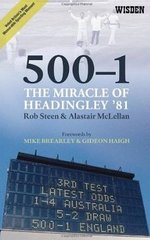500-1: The Miracle of Headingley ’81
David Taylor |Published: 2001
Pages: 288
Author: Steen, R and McLellan, Alistair
Publisher: BBC Worldwide
Rating: 4 stars

After the trials of the England team in Australia and since this might prove an uplifting read for us Poms. It is, of course, the in-depth story of the extraordinary Leeds Test of 1981, about which Patrick Murphy wrote, in his excellent Fifty Incredible Cricket Matches, now we really are deep into script rejection time. Anybody who sat down and penned a scenario on the lines of this game would be laughed out of every publisher’s office. Murphy was writing only five years after the match, but more than thirty years on the legend is undimmed. Despite strong competition from Kolkata 2001 and Edgbaston 2005, among others, this is still the greatest Test of all for many, only the second occasion in Test history that a side won after following on.
The name of Rob Steen is familiar to me through his work with Cricinfo and the New Ball series. His co-writer Alastair McLellan is rather less so; he doesn’t seem to have written on cricket at any rate. The book is rather older than I thought when I bought it, and was presumably published to coincide with the twentieth anniversary of the match. In passing i should mention that the man I bought it from is among the contributors! The book seller David Summerfield and his son Keith are the regular bookstall holders at Canterbury and contribute to an ‘I was there’ section – both were too modest to mention it to me at the time of purchase.
Much time and effort is expended setting up the match. We are up to page 62 before we even get to the teams, both profiled in detail. Before that there is a foreword by Mike Brearley and a long opening chapter reminding us of the state of Britain (and English cricket) in the summer of 1981. As well as the expected references – the royal wedding, the summer riots in Liverpool and elsewhere – there is a good deal about the other news stories and personalities of the day, as well as the TV and music people were enjoying. This perhaps goes on a little too long, and some of the references went over my head, but of course every reader’s recollection will be different, and the writers certainly couldn’t be accused of selling their audience short.
Finally, we get to the match itself. I should say here that I was looking forward to reading this book possibly more than any other I have picked up. I genuinely hoped it would form the subject of a five star review. I’m unable to do that because of the way the match itself is covered, which for me doesn’t quite work. It’s done in the form of imagined daily newspaper reports, and the play is covered in detail. But all the ‘England are doomed’ stuff doesn’t quite ring true, because not only do we know what happens next, we know that the writer knows too. The tension, such as it is, is necessarily artificial.
Anyway that is a minor criticism of an extremely enjoyable book. The post-match sections include interviews with several of the players on both sides – the contribution from the late Graham Dilley proving particularly revealing. In an echo of the Sobers ‘six sixes’ match, there is an attempt to find out what happened to the ball with which Bob Willis took eight wickets. And as mentioned above, there are reminiscences of many ordinary fans who were there, or who watched the compelling climax on TV. Finally there is a ‘where are they now’ section – we know where Willis and Ian Botham, the twin heroes of the last two days, can be found, of course. It remains only to add that there is a fine selection of black and white and colour photographs. If you are an England supporter I should track down this book; it may help you to forget the last eight months.






Leave a comment